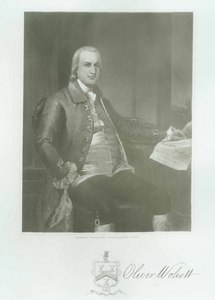
Oliver Wolcott Engraving
F. B. Longaire
Gender:
Male
Born:
November 20, 1726
Died:
December 1, 1797
Marriage(s):
Laura Collins Wolcott (January 21, 1755)
Biographical Notes:
Oliver Wolcott was born on November 20, 1726, the youngest child in a prominent Connecticut family. His father, Roger Wolcott, was one of the first governors of the colony of Connecticut. His mother was Sarah Drake. He had three brothers who survived childhood (Alexander, Josiah, and Erastus) and four sisters (Sarah, Hephzibah, Ursula, and Mariann). They lived in Windsor, Connecticut, where both of Oliver's parents grew up.
Wolcott graduated from Yale in 1747. Afterwards, he was a captain in the army and studied medicine with his brother Alexander. In 1751, he found his way to Litchfield once it was appointed as the county seat for Litchfield County. He was elected as the first Sheriff of Litchfield that same year. He was a representative of Litchfield in the General Assembly and
...was a member of the militia. In July of 1775, he served as a Commissioner of Indian Affairs for the Northern Department.
In the years leading up to the Revolutionary War, Wolcott served as a representative to the Continental Congress for the state of Connecticut. In that capacity, he became one of the signers of the Declaration of Independence (Oliver Wolcott's signature appears in the right-most column, second from the bottom).
During the fighting of the Revolution, Oliver commanded fourteen regiments and was made a Brigadier General in early 1777. From February to July of 1778, he attended the Congress at Yorktown.
His home was also busy during the Revolution. Not only did George Washington stay there, but it was the focal point in Wolcott's scheme to create bullets for the Continental Army. In July 1776, a lead statue of King George III astride a horse in central Manhattan was torn down and cut into pieces. Wolcott then had these pieces brought to his home in Litchfield where it they were melted down and made into bullet cartridges.
In 1786, Oliver was elected Lieutenant-Governor of Connecticut. It was a post he held for ten years. He was a signer of the Articles of Confederation. In 1787, he was a member of the Connecticut State Convention, which voted for the ratification of the Constitution of the United States. In 1796 he was a presidential elector (he voted for John Adams, who was elected President). That same year, the town of Wolcott, Connecticut was named after the Lieutenant-Governor when he cast the deciding vote in the state legislature to incorporate the town.
Oliver then became the Governor of Connecticut after Governor Samuel Huntington died in office in early 1796. Oliver was reelected Governor, but he died in office on December 1, 1797. He is buried in the East Cemetery in Litchfield (less than a mile down the road from the Historical Society).
Wolcott married Laura Collins of Guilford, Connecticut. The couple had two sons and two daughters. Both daughters married prominent men (William Moseley, a lawyer and member of the Connecticut legislature and Chauncey Goodrich, Congressman, Senator, and state Lieutenant-Governor). His sons were Oliver Jr. and Frederick.
Wolcott was also somewhat responsible for shaping the aesthetic of the town of Litchfield. Under his direction, 13 large sycamore trees were planted North and South Streets in honor of the original colonies (although only one remains today: it is the Connecticut tree, located on South Street by St. Anthony's Church). A grander contribution, though, came in the design and construction of his house in 1752. At the time of its construction, it was the foremost domestic building in the town, reflecting the status and wealth of the family. The Georgian styling on the house was new and fashionable, although the house retained classic Connecticut design elements with its central chimney and gable-end overhangs. This combination of the two styles would remain pervasive in Connecticut through the Revolution and was a reflection of the unique area aesthetic.[more][less]
Profession:
Political Office
Secondary Sources:
Carley, Rachel. Litchfield: The Making of a New England Town. Connecticut: GHP, 2011.
Do you have more information for the Ledger?
If you have family papers, objects, or any other details you would like to share, or if you would like to obtain a copy of an image for publication, please
contact us at curator@litchfieldhistoricalsociety.org.
